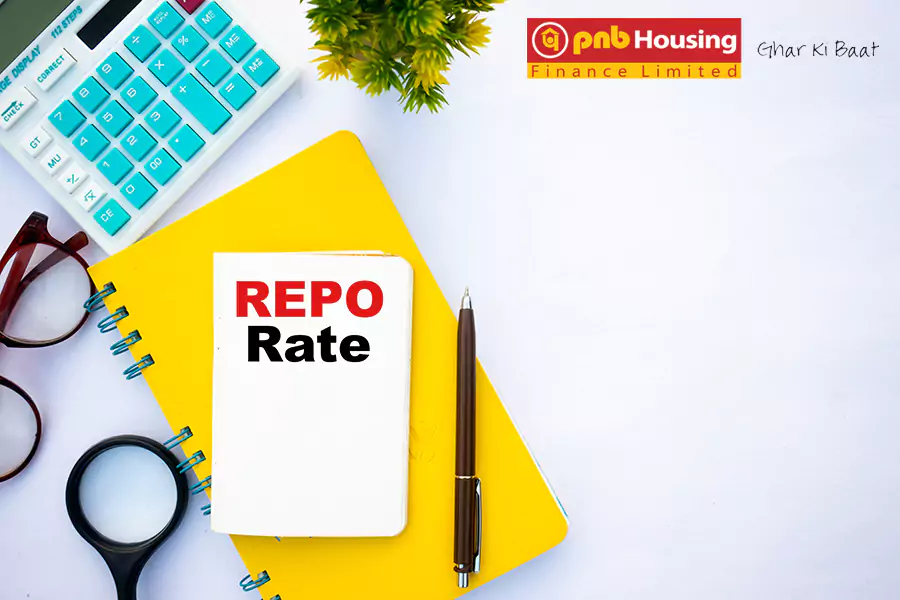The repo rate, set by the Reserve Bank of India (RBI), plays a crucial role in shaping home loan interest rates. Changes in the repo rate directly impact EMIs, loan affordability, and borrowing costs for homebuyers. A higher repo rate means costlier loans, while a lower rate can lead to cheaper EMIs. Understanding its impact helps borrowers make smarter financial decisions when planning a home loan. In this blog, we’ll explore the importance of repo rate in home loans, and how it affects your loan repayment and overall financial stability.
How Does Repo Rate Work?
Repo rates help a central bank to manage and maintain a sound and robust financial system of the economy. It is broadly defined as the interest rate at which the central bank lends money to commercial banks.
The central bank in India, i.e. the Reserve Bank of India (RBI), uses repo rates to manage and maintain healthy and sustainable liquidity in the financial system. When there is a shortage of funds, commercial banks borrow money from the RBI, which is paid back according to the repo rate. The central bank increases the repo rate when it needs to control prices and restrict borrowings. On the other hand, the repo rate is decreased when there is a need to infuse more money into the market and support economic growth.
Reverse Repo Rate Meaning
The rate offered by RBI to commercial banks is used to park their excess funds in the central bank. Reverse repo rate is also a monetary policy regulated by RBI to maintain the flow of money in the market. As per requirement, RBI borrows money from commercial banks and pays them interest at the reverse repo rate applicable. At a given point in time, the reverse repo rate provided by RBI is generally lower than the repo rate.
While the repo rate is used to regulate liquidity in the economy, the reverse repo rate is used to control cash flow in the market. Contrary to the repo rate, RBI increases the reverse repo rate to encourage commercial banks to make deposits in the central bank and earn returns during inflation.
Must Read: Fixed Vs Floating Interest Rate: Which Is Better For Home Loan?
How is the Repo Rate Determined?
The Reserve Bank of India (RBI) determines the repo rate based on inflation levels, economic growth, and liquidity conditions in the market. The Monetary Policy Committee (MPC) meets bi-monthly to review economic indicators and adjust the rate accordingly. When inflation is high, RBI raises the repo rate to reduce excess liquidity and control price rises. Conversely, during slow economic growth, RBI lowers the repo rate to encourage borrowing and spending. This dynamic policy helps maintain economic stability and financial growth.
For example, in February 2024, the RBI decided to keep the repo rate unchanged at 6.50% to balance inflation control and economic growth (Source: RBI Monetary Policy Statement, February 8, 2024). Similarly, in May 2022, RBI hiked the repo rate from 4.00% to 4.40% due to rising inflation. These decisions directly impact loan interest rates and borrowing costs.
Repo Rate and its Impact on Home Loans
The effect of repo rates on home loans is not direct yet significant. An increase in the repo rate means commercial banks have to pay more interest for the money they borrow from RBI. Therefore, a change in repo rate eventually affects public borrowings such as Home Loans. From interest charged by commercial banks on loans to the returns from deposits- everything is indirectly dependent on the repo rate.
When there is a hike in the repo rate, home loans will be priced higher, and the majority of existing home loans with floating interest rates will see a rise in their EMIs (Equated Monthly Instalments).
Additionally, the interest rates for existing borrowers are linked to the financial institution’s internal benchmark rate, which indirectly depends on the current repo rate. The applicable interest rate, hence, will be calculated after factoring in the borrowing cost, internal benchmark rate & credit spread.
How Does Repo Rate Impact EMI
Let’s consider an example to understand the repo rate’s effects on home loan EMI. On a running home loan of Rs. 50 lakh with a tenure of 20 years at 7% monthly interest; if the rate increases to 7.4%, then the EMI will increase to Rs. 39,974 from Rs. 38,765. Alternatively, the rise in interest rate can be absorbed by increasing the loan tenure, hence keeping the EMI the same. In any case, a financial institution informs its customers about the reset in EMI or Tenure of loan.
Current Repo Rate
The Reserve Bank of India (RBI) frequently adjusts the repo rate and reverse repo rate in response to changing economic conditions. In its Monetary Policy Committee (MPC) meeting on February 7, 2025, the RBI cut the repo rate by 25 basis points to 6.25% after maintaining it at 6.50% for two years. The reverse repo rate remains unchanged at 3.35%. The Bank Rate and Marginal Standing Facility (MSF) rate have been revised to 6.50%, while the Standing Deposit Facility (SDF) Rate stands at 6.00%.
Why Do Repo Rate Changes Matter to Home Loan Borrowers?
Repo rate changes directly impact home loan interest rates, EMIs, and overall borrowing costs. When the RBI increases the repo rate, banks pass on the higher borrowing cost to customers, leading to higher EMIs for floating-rate home loans. Conversely, when the repo rate is reduced, home loan interest rates may decrease, making EMIs more affordable. Fixed-rate borrowers remain unaffected, but new loan applicants and existing floating-rate borrowers experience changes. Monitoring repo rate movements helps borrowers plan finances effectively and optimise loan repayment strategies.
How Borrowers Can Manage Home Loans During Repo Rate Fluctuations
To manage home loans during repo rate fluctuations, borrowers can opt for floating-rate loans when rates are low and fixed-rate loans when rates are high. If the repo rate rises, borrowers can increase EMIs or make prepayments to reduce total interest costs. Refinancing to a lender offering better terms can also help. Additionally, using a home loan EMI calculator to reassess financial commitments ensures better planning. Staying informed about RBI’s monetary policy decisions helps borrowers adjust their loan strategies accordingly.
A borrower with a ₹50 lakh home loan at 7.5% interest for 20 years had an EMI of ₹40,280. When the repo rate increased, the interest rate rose to 8.0%, pushing the EMI to ₹41,822. To manage this, the borrower increased EMI payments and made partial prepayments, reducing the total interest paid over time.
Recent Trends in Repo Rate and Their Effects on Home Loan Borrowers
The Reserve Bank of India (RBI) reduced the repo rate to 6.25% in February 2025 after holding it at 6.50% for two years. This rate cut directly impacts home loan borrowers, especially those with repo rate-linked loans, as it leads to a decrease in interest rates and Equated Monthly Instalments (EMIs).
For example, consider a borrower with a ₹50 lakh home loan at an 8.50% interest rate for 20 years. With a 0.25% rate cut, their EMI could reduce by approximately ₹750–₹1,000 per month, leading to substantial long-term savings. Lower borrowing costs encourage more home purchases and refinancing opportunities.
However, repo rate-linked loans come with faster transmission of rate changes, meaning that if the RBI increases rates in the future, borrowers may see their EMIs rise quickly. Staying informed and refinancing strategically can help borrowers manage their home loan costs effectively.
FAQs
What impact does an increase in the repo rate have on consumer loans like home loans and auto loans?
When the repo rate increases, banks face higher borrowing costs, leading to higher interest rates on home loans, auto loans, and personal loans. This results in higher EMIs for borrowers, making loans more expensive. Existing floating-rate borrowers are directly impacted, while fixed-rate borrowers remain unaffected.
What will happen if the repo rate is increased?
An increase in the repo rate raises loan interest rates, leading to higher EMIs for borrowers. It also reduces liquidity in the economy, discouraging excessive borrowing and controlling inflation. However, savings account and fixed deposit (FD) rates may increase, benefiting depositors with higher returns.
Can borrowers switch from a floating rate to a fixed rate if the repo rate rises?
Yes, borrowers can switch from a floating rate to a fixed rate if the repo rate rises, but it depends on lender policies and conversion fees. Fixed rates provide stability in EMIs, preventing future rate hikes from affecting loan costs. Borrowers should compare conversion costs and market trends before switching.
How quickly do banks adjust their loan rates after a repo rate change?
Banks typically adjust loan rates within weeks of an RBI repo rate change, especially for floating-rate loans. Most home loan rates are linked to external benchmarks like the repo rate, causing automatic adjustments. Fixed-rate loans remain unchanged, while banks may revise deposit rates in response to monetary policy shifts.























